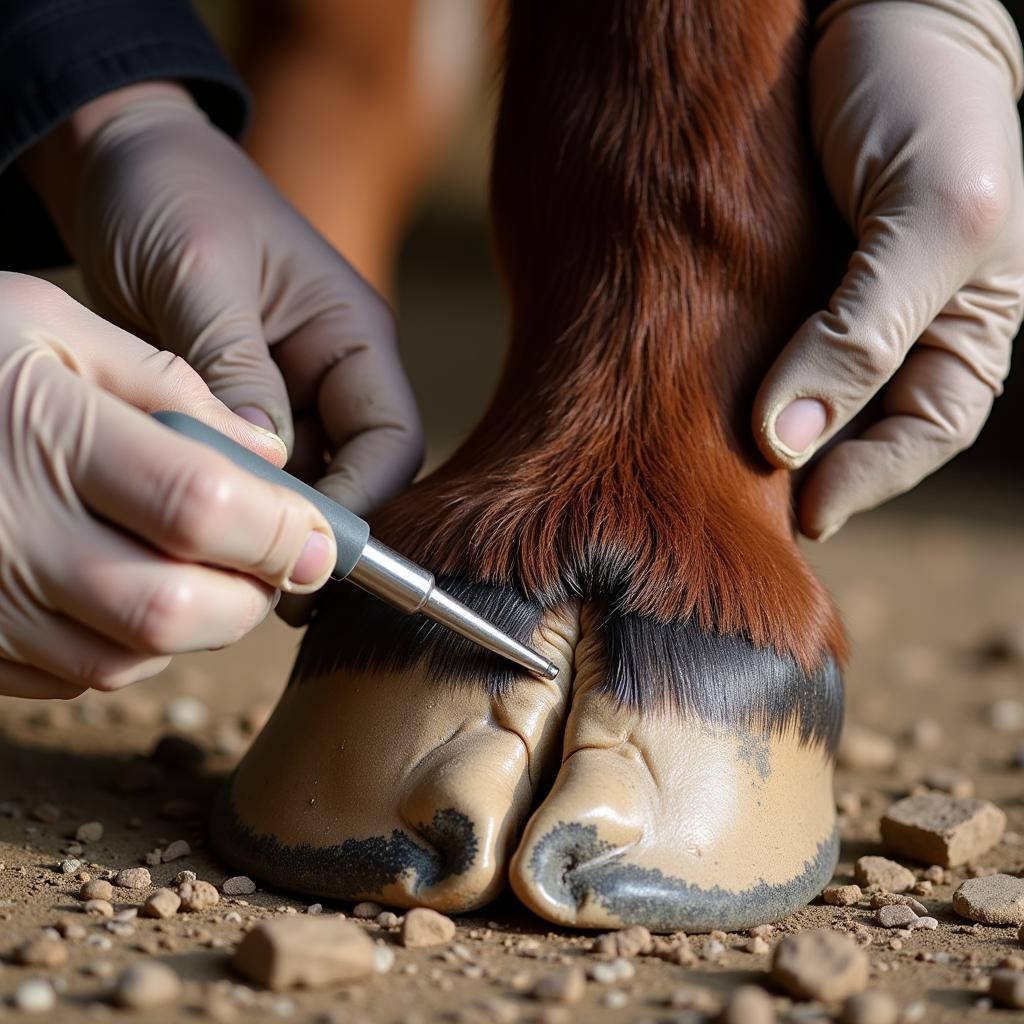Horse Hoof Epoxy is a versatile and powerful tool in every farrier’s and horse owner’s arsenal. It can be used for everything from repairing cracks to building up weakened areas of the hoof. Understanding its uses, application, and limitations is crucial for ensuring your horse’s hoof health.
Understanding Horse Hoof Epoxy: What is it and Why Use It?
Horse hoof epoxy is a two-part adhesive system specifically formulated for equine hoof repair. It provides a strong, durable bond that can withstand the rigors of daily wear and tear. It’s used to address a variety of hoof problems, offering a more permanent solution compared to traditional methods like acrylics. Hoof epoxy is particularly useful for repairing cracks, filling defects, and securing shoes. Its strength and flexibility make it ideal for supporting damaged hoof walls and promoting healthy hoof growth.
Benefits of Using Horse Hoof Epoxy
- Strength and Durability: Epoxy provides a robust bond, crucial for withstanding the stresses placed on hooves.
- Flexibility: Despite its strength, epoxy maintains a degree of flexibility, mimicking the natural movement of the hoof.
- Water Resistance: This crucial property prevents water from penetrating the hoof and causing further damage or infection.
- Versatility: Epoxy can be used for a range of applications, from minor repairs to more complex reconstructions.
- Long-Lasting: A properly applied epoxy repair can last for several weeks, reducing the need for frequent farrier visits.
 Applying Horse Hoof Epoxy
Applying Horse Hoof Epoxy
How to Apply Horse Hoof Epoxy: A Step-by-Step Guide
Applying hoof epoxy correctly is essential for achieving optimal results. Follow these steps for a successful application:
- Clean the Hoof: Thoroughly clean and dry the hoof, removing any dirt, debris, and loose hoof material. This ensures a strong bond between the epoxy and the hoof wall.
- Prepare the Epoxy: Mix the two parts of the epoxy according to the manufacturer’s instructions. Accurate mixing is vital for proper curing.
- Apply the Epoxy: Apply the mixed epoxy to the affected area using a putty knife or similar tool. Ensure complete coverage and a smooth finish.
- Cure Time: Allow the epoxy to cure completely according to the manufacturer’s instructions. Avoid exposing the hoof to moisture during the curing process.
Common Mistakes to Avoid
- Insufficient Cleaning: Dirt and debris can weaken the bond between the epoxy and the hoof.
- Incorrect Mixing Ratios: Improper mixing can result in a weak or brittle repair.
- Applying Too Much Epoxy: Excessive epoxy can create pressure points and discomfort for the horse.
- Insufficient Curing Time: Handling the hoof before the epoxy is fully cured can compromise the repair.
Choosing the Right Horse Hoof Epoxy
Selecting the appropriate epoxy is crucial for achieving the best results. Consider these factors when choosing a product:
- Strength and Flexibility: Look for an epoxy that offers a balance of strength and flexibility to mimic the natural hoof.
- Curing Time: Consider the curing time based on the horse’s activity level and environment.
- Color: Choose a color that blends in with the hoof for a more natural appearance.
- Application Method: Select a product with an application method that suits your skill level and equipment.
“Selecting the right epoxy is paramount,” says renowned farrier, John Smith, CF. “The correct product ensures a durable and effective repair, promoting long-term hoof health.”
Conclusion
Horse hoof epoxy is a valuable tool for addressing a range of hoof issues. Understanding its proper application, choosing the right product, and avoiding common mistakes are crucial for achieving optimal results and ensuring your horse’s hoof health. By following these guidelines, you can effectively utilize horse hoof epoxy to maintain strong and healthy hooves for your equine companion.
FAQs
- How long does horse hoof epoxy last? A properly applied epoxy repair can typically last for several weeks, depending on the horse’s activity level and environment.
- Is horse hoof epoxy safe for horses? Yes, horse hoof epoxy is specifically formulated for equine use and is safe when applied correctly.
- Can I apply horse hoof epoxy myself? While minor repairs can be attempted by experienced horse owners, it’s generally recommended to consult a qualified farrier for any significant hoof issues.
- What are the alternatives to horse hoof epoxy? Alternatives include acrylics and other hoof repair materials, but epoxy often provides a more durable and long-lasting solution.
- How do I remove horse hoof epoxy? Epoxy can be removed using a hoof rasp or other specialized tools. It’s best to consult a farrier for removal to avoid damaging the hoof.
- How much does horse hoof epoxy cost? The cost of horse hoof epoxy varies depending on the brand and quantity, but it is generally an affordable hoof repair option.
- Where can I buy horse hoof epoxy? Horse hoof epoxy can be purchased from farrier supply stores, online retailers, and some tack shops.
When you need assistance, contact us at Phone Number: 0772127271, Email: [email protected] Or visit us at: QGM2+WX2, Vị Trung, Vị Thuỷ, Hậu Giang, Việt Nam. We have a 24/7 customer support team.